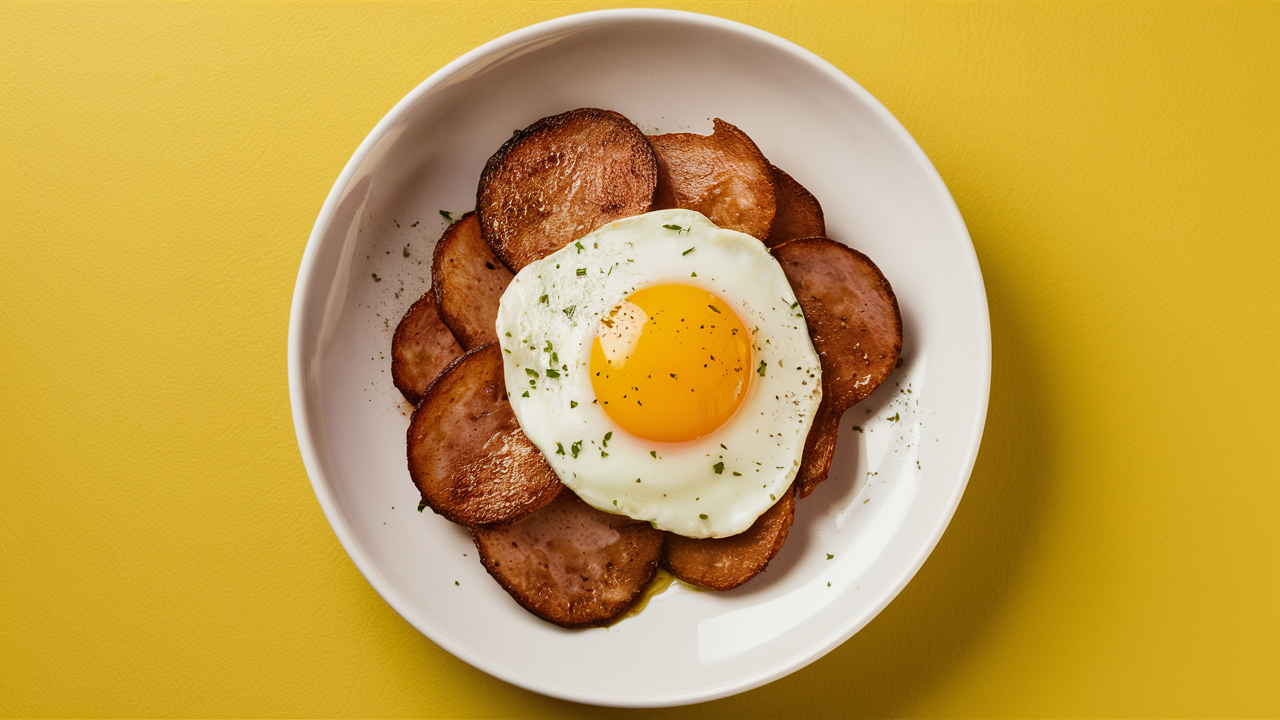Introduction to Bologna and Egg
Bologna and egg, a pairing celebrated in various cuisines, offers a delightful mix of flavors embraced globally. Particularly popular in American breakfast and lunch menus, this combination serves as a hearty meal that satisfies at any time of day. Traditionally, bologna—a seasoned sausage made from blended meat—complements the subtle flavors of cooked eggs, whether fried, scrambled, or poached.
This duo not only appears in simple, quick meals but also stars in elaborate dishes across different cultures, illustrating its versatility. In the United States, the bologna and egg sandwich, often grilled or fried until crispy, emerges as a beloved classic. Meanwhile, culinary traditions in Europe might feature bologna slices alongside soft-boiled eggs as part of a broader breakfast spread.
Moreover, the ingredients’ affordability and availability contribute to their popularity. They offer a practical solution for nutritious meals without compromising on taste. Both bologna and eggs provide essential proteins and other nutrients, making them a favored choice for a fulfilling start to the day or a satisfying midday meal. Together, they encapsulate a fusion of simplicity and comfort, continuing to endear themselves to people of all ages.
What is Bologna?
Bologna comes from Bologna, Italy, where it evolved from the traditional Italian sausage, Mortadella. American bologna typically combines pork and beef with various seasonings. Workers finely grind this meat mix, then smoke and cure it to create its unique flavor and texture.
You can find bologna in several types, such as classic, garlic, and spicy, each offering distinct taste profiles. In the kitchen, bologna proves versatile. Cooks often slice and fry it for breakfast or sandwiches, and also mix it into casseroles or serve it with crackers and cheese. Its affordability and long shelf life also make it a staple for quick, economical meals in many cultures.
Health and Nutritional Profile of Bologna and Eggs
Bologna and eggs each offer unique nutritional benefits. Eggs are renowned for their high-quality protein and essential nutrients. A large egg typically provides about 6 grams of protein along with vital vitamins and minerals such as vitamin D, vitamin B12, selenium, and choline. These contribute to bone health, brain function, and overall cellular maintenance.
Bologna, while also protein-rich, is higher in calories and fat. A standard slice may have up to 7 grams of protein but also includes about 9 grams of fat and considerable sodium. It also contains additives like sodium nitrite, which could pose health risks if consumed frequently.
Eaten in moderation, bologna can fit into a balanced diet. It offers iron and zinc, which support oxygen transport and immune health. Choosing lower-sodium and reduced-fat versions can enhance its nutritional profile.
Pairing bologna with eggs can increase a meal’s protein content, making it more filling and balanced. It’s beneficial to include high-fiber foods such as whole grains or vegetables in the meal to balance the fats and add nutritional value.
Cooking and Serving Bologna and Egg

Skillet Method
- Preheat the Skillet: Start by heating a skillet over medium heat. Lightly grease it with a small amount of butter or oil to prevent sticking.
- Cook the Bologna: Place bologna slices in the skillet. Make small slits around the edges to prevent them from curling. Fry for about 2 minutes on each side until browned and crispy.
- Fry the Eggs: Reduce the heat to medium-low. Crack the eggs directly into the skillet. Season with salt and pepper. Cook until the whites solidify while keeping the yolks liquid and visibly runny. For over-easy, flip the eggs after the whites set and cook for an additional minute.
Air Fryer Method
- Preheat the Air Fryer: Adjust the air fryer’s temperature to 375°F (190°C) and allow it to warm up.
- Prepare the Bologna: Place bologna slices in the air fryer basket. Optionally, sprinkle a little paprika or garlic powder on them before cooking.
- Cook the Bologna: Air fry for about 4 minutes, then flip the slices and cook for another 3-4 minutes until they are crispy.
- Cook the Eggs: Use a small, oven-safe dish or ramekin. Crack an egg into the dish, season with salt and pepper, and place it in the air fryer. Cook at 375°F for about 8 minutes, or until the egg is cooked to your liking.
Serving Suggestions
Serve the fried bologna and egg with a side of toasted bread or on a sandwich with mayonnaise and mustard. Add a side of fresh fruit or roasted vegetables to balance the meal with a light, nutritious component.
Recipe Ideas with Bologna and Eggs
Bologna and eggs offer versatile and delicious options for meals throughout the day. Here are some creative recipes to incorporate these ingredients into your cooking:
1. Classic Bologna and Egg Sandwich
- Ingredients: Thinly sliced bologna, eggs, cheese, and bread.
- Preparation: Fry slices of bologna until crispy. Next, cook the eggs in the same pan to achieve your preferred level of doneness.. Assemble sandwiches with cheese melting over the hot bologna and eggs.
2. Bologna Breakfast Burrito
- Ingredients: Bologna, eggs, shredded cheese, salsa, and tortillas.
- Preparation: Chop bologna and fry until crispy. Scramble eggs and mix with bologna. Fill tortillas with the mixture, top with cheese and salsa, and roll up.
3. Bologna and Egg Hash
- Ingredients: Chopped bologna, diced potatoes, eggs, onions, and bell peppers.
- Preparation: Cook potatoes until golden, add bologna and veggies, and cook until tender. Crack eggs over the hash, cover, and cook until the eggs set.
4. Cheesy Bologna and Egg Muffins
- Ingredients: Bologna slices, eggs, milk, shredded cheese, and seasoning.
- Preparation: Line muffin tins with bologna to form cups. Whisk eggs with milk and cheese, pour into bologna cups, and bake until set.
5. Spicy Bologna and Egg Stir Fry
- Ingredients: Sliced bologna, eggs, spicy sauce (like Sriracha), vegetables.
- Preparation: Stir-fry bologna and vegetables in a hot skillet. Add beaten eggs and cook quickly. Drizzle with spicy sauce before serving.
Each of these recipes brings out the unique flavors of bologna and eggs in different ways, catering to various tastes and meal preferences. Whether you’re looking for a hearty breakfast, a quick lunch, or a satisfying dinner, these ideas offer easy ways to enjoy these classic ingredients.
Serving Suggestions for Bologna and Egg Dishes
To enhance the flavor and nutritional value of bologna and egg dishes, consider these serving tips:
- Add Fresh Vegetables: Complement bologna and eggs with a side of sautéed spinach, mushrooms, or asparagus. These vegetables add freshness, fiber, and vitamins to your meal.
- Incorporate Whole Grains: Serve bologna and egg dishes with whole grain toast or a whole wheat wrap. These grains offer additional fiber and nutrients, making the meal more balanced and satisfying.
- Include a Salad: Pair a bologna and egg breakfast with a fresh garden salad dressed with a light vinaigrette. This adds color and essential nutrients without too many extra calories.
- Offer Fruit: A side of fresh fruit can brighten up a bologna and egg plate with natural sweetness and a boost of antioxidants. Consider berries, orange slices, or a mixed fruit salad.
- Use Healthy Fats: Drizzle avocado slices or a spoonful of guacamole on top of your bologna and egg dish. Avocado provides healthy fats that are good for heart health.
- Choose Low-Fat Dairy: When adding cheese to bologna and egg recipes, opt for low-fat options like mozzarella or Swiss cheese to keep the dish lighter.
Each of these suggestions not only enhances the flavors and textures of your bologna and egg meals but also contributes to a more nutritious dining experience. Whether you’re preparing a hearty breakfast or a light dinner, these additions can make your dish tastier and healthier.
Creative Ways to Enjoy Bologna and Eggs

Adding another section to your article can provide readers with innovative and fun ideas to use bologna and eggs beyond the basic recipes. This part will explore creative dishes that can revitalize their perception of these common ingredients.
1. Bologna and Egg Salad
- Overview: Transform the classic egg salad by adding diced bologna for extra flavor and texture. Combine hard-boiled eggs, diced bologna, celery, and onions with a light yogurt-based dressing for a refreshing twist on a traditional dish.
2. Bologna Egg Cups
- Overview: Use slices of bologna as a makeshift cup to hold eggs and vegetables. Press bologna slices into muffin tins, crack an egg into each, season with salt, pepper, and herbs, and bake until the eggs are set. It’s a perfect portion-controlled breakfast or snack that’s easy to make.
3. Spicy Bologna and Scrambled Egg Tacos
- Overview: Give your breakfast a Mexican twist. Scramble eggs with chopped bologna, onions, and jalapeños. Serve in warm tortillas with salsa and a sprinkle of cheddar cheese for a spicy, hearty start to the day.
4. Bologna and Egg Stir-Fry
- Overview: Slice bologna and fry with vegetables like bell peppers, onions, and broccoli. Add beaten eggs and scramble. Serve this colorful stir-fry over rice or noodles for a quick and satisfying meal.
5. Cheesy Bologna and Egg Bake
- Overview: Layer slices of bologna with scrambled eggs, spinach, mushrooms, and lots of cheese. Bake until golden and bubbly for a delicious brunch dish that can feed a crowd.
Each of these ideas not only extends the culinary uses of bologna and eggs but also adds a new layer of enjoyment to these everyday ingredients. Experimenting with these combinations can lead to delightful new meals that might just become new favorites.
FAQs on Cooking and Storing Bologna and Eggs
What are the best ways to cook bologna and eggs for optimal health benefits?
To maximize health benefits, cook bologna and eggs with methods that use less oil. For bologna, consider baking or air frying instead of deep frying to reduce fat content. Eggs can be poached, boiled, or scrambled with minimal oil. Incorporating vegetables can also boost nutritional value, providing fiber, vitamins, and minerals.
Does bologna need to be cooked?
Bologna is typically pre-cooked and safe to eat straight from the package. However, cooking it can enhance its flavor and make it more appetizing. Frying or grilling bologna until it has a crispy edge is a popular preparation method.
How should bologna and eggs be stored properly?
To ensure freshness and safety, store bologna in the refrigerator, tightly wrapped to prevent air exposure, which can lead to spoilage. It usually lasts for one to two weeks in the fridge. For extended preservation, you can freeze bologna, and it will remain good for about two months.. Eggs should be stored in their original carton in the main body of the refrigerator, not in the door, as temperatures tend to fluctuate there. Properly stored, eggs can last about three to five weeks from the purchase date.
These tips ensure that your bologna and eggs remain tasty and safe to eat, while also helping you make healthier choices in preparation and storage. Cooking techniques that minimize added fats and storage methods that preserve freshness can significantly enhance your meals’ health benefits.
Conclusion: Exploring the Versatility of Bologna and Eggs
Bologna and eggs, staples in many kitchens, offer a delightful combination of flavors and textures that can be enjoyed in countless ways. Whether you’re whipping up a quick breakfast sandwich, a hearty brunch, or a simple yet satisfying dinner, these ingredients provide both convenience and comfort. The variety of cooking methods, from air frying to boiling, allows for flexibility in texture and taste while catering to health preferences.
We’ve explored not only how to cook and serve bologna and eggs but also how to store them properly to maximize freshness and safety. Remember, while bologna is convenient due to its pre-cooked nature, cooking it can elevate the flavor and make it a warm, crispy treat. Eggs, with their high protein and rich nutrient profile, complement bologna perfectly, making any meal more substantial and nourishing.
Ultimately, the key to incorporating bologna and eggs into your diet healthily is moderation and balance. Pairing them with vegetables and whole grains can enhance their nutritional value, making your meals not only delicious but also well-rounded. So next time you find yourself reaching for these ingredients, remember the tips and recipes discussed, and enjoy creating meals that are both tasty and wholesome.

